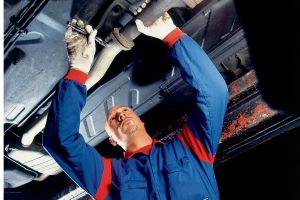A
Auto Express
Guest
As we all work towards becoming more eco-friendly, with hybrid and electric cars continuing to grow in popularity, diesel has come under ever-increasing criticism for its role as a polluter. Sales of diesel cars are firmly on the decline and increasingly strict emissions regulations have forced car makers to introduce various solutions to reduce the amount of harmful pollutants coming from diesel exhausts. Diesel is still popular, however, and one of the technologies that’s commonplace on modern diesel cars, helping them to these lower emissions levels, is something known as a Diesel Particulate Filter, or DPF for short.
This piece of kit has been found on diesel cars for years, whether they're built by BMW, Audi, Ford or any other manufacturer. For the most part it operates in the background and the first time car owners become aware of their car’s Diesel Particulate Filter is when it becomes blocked and a DPF warning light appears on the dash, or when the automatic regeneration process causes a cloud of black smoke to emerge from the exhaust. In this guide, we’ll look at the DPF in detail, explaining what it is, how it works and common problems.
What is a DPF?
The DPF is part of a diesel engine's exhaust system, and it is used to collect soot and other particles that are generated when the diesel fuel is burned inefficiently by the engine. These inefficiencies can happen because a diesel car is old or in need of a service, although diesel cars that do lots of short low-speed journeys where the engine doesn't warm up enough can also be less efficient and generate more of these particulate emissions as a result.

Diesel - pump

MOT test fail for DPF removal

Volkswagen Golf GTD 2017 facelift - front tracking
The diesel particulate filter works in a similar way to a catalytic convertor. It operates by trapping the pollutants within it as the exhaust gases pass through. The most common material used in a DPF is the same as you'll find in a cat, too. This material is called cordierite, it is a ceramic material that is efficient at absorbing soot and other deposits that are commonly found in diesel exhaust. Cordierite is relatively inexpensive when compared to some of the other materials found in exhaust filtration systems, which helps keep DPF replacement costs down should the need arise. The clever part of a DPF is that it's 'self-cleaning' and can regenerate to carry on cleaning your exhaust gases, which allows the part to last for longer.
When the time to replace does come around, a car's electronics can detect when the DPF becomes filled with particulate matter and soot, and can set about forcing out clogged material when necessary. This usually happens when a car is being driven at speed, however some filters can also be unclogged with the car parked and the engine running at a higher idle speed.
As with any car part, If a DPF isn't cared for properly then problems can arise. The biggest problem with DPFs is that they don't cope well with light use. So if you've got a diesel car that is exclusively used around town on low-speed journeys that don't see you revving the engine very much, the ‘self-cleaning’ system cannot run, resulting in the DPF becoming clogged. A precursor to a DPF failure will be a warning light on the dashboard. If this illuminates, then you need to seek remedial action from a service centre as soon as possible.
The way to clean and regenerate a DPF is to get the car warmed up and give it some revs. If you go for a 20-minute drive, then that should heat things up nicely, and then what you need to do is find a stretch of fast road or motorway where you can accelerate your car. Do this, and you should see a telltale cloud of soot purge itself from your exhaust and into the road behind - it looks unpleasant and could fool you into thinking that you have a major fault, but don’t worry as it is ultimately a good thing as your car will feel the benefit immediately.

Diesel - pump

MOT test fail for DPF removal

Volkswagen Golf GTD 2017 facelift - front tracking
Some people may be tempted to bypass any DPF issues by removing it from their car, but this is definitely not recommended. Not only will your car constantly belch smoke and other nasties into the air, but it could fail its annual MoT test due to the increased level of pollutants that are no longer controlled by your car's exhaust system. If you are buying a used diesel then be sure to check if this has been carried out by a previous owner.
Having said that, unless the car's emissions are affected, it's hard for an MoT test station to detect whether a DPF has been removed. Unscrupulous owners can easily remove the DPF assembly, and some garages even offer a DPF removal service. These take out the filters and remount the empty housing, so it looks like the DPF is fitted as normal. And because the MoT only requires a visual inspection that all emissions kit is present, the MoT tester would be none the wiser. If you are caught driving a car without its DPF in place, you could face a fine of up to £1,000, so not only can it damage the environment but your bank account too.
Have you had any problems with DPFs that we should know about? Let us know in the comments below.
Continue reading...
This piece of kit has been found on diesel cars for years, whether they're built by BMW, Audi, Ford or any other manufacturer. For the most part it operates in the background and the first time car owners become aware of their car’s Diesel Particulate Filter is when it becomes blocked and a DPF warning light appears on the dash, or when the automatic regeneration process causes a cloud of black smoke to emerge from the exhaust. In this guide, we’ll look at the DPF in detail, explaining what it is, how it works and common problems.
What is a DPF?
The DPF is part of a diesel engine's exhaust system, and it is used to collect soot and other particles that are generated when the diesel fuel is burned inefficiently by the engine. These inefficiencies can happen because a diesel car is old or in need of a service, although diesel cars that do lots of short low-speed journeys where the engine doesn't warm up enough can also be less efficient and generate more of these particulate emissions as a result.
- SEE MORE Best diesel cars 2021

Diesel - pump

MOT test fail for DPF removal

Volkswagen Golf GTD 2017 facelift - front tracking
The diesel particulate filter works in a similar way to a catalytic convertor. It operates by trapping the pollutants within it as the exhaust gases pass through. The most common material used in a DPF is the same as you'll find in a cat, too. This material is called cordierite, it is a ceramic material that is efficient at absorbing soot and other deposits that are commonly found in diesel exhaust. Cordierite is relatively inexpensive when compared to some of the other materials found in exhaust filtration systems, which helps keep DPF replacement costs down should the need arise. The clever part of a DPF is that it's 'self-cleaning' and can regenerate to carry on cleaning your exhaust gases, which allows the part to last for longer.
When the time to replace does come around, a car's electronics can detect when the DPF becomes filled with particulate matter and soot, and can set about forcing out clogged material when necessary. This usually happens when a car is being driven at speed, however some filters can also be unclogged with the car parked and the engine running at a higher idle speed.
DPF problems
As with any car part, If a DPF isn't cared for properly then problems can arise. The biggest problem with DPFs is that they don't cope well with light use. So if you've got a diesel car that is exclusively used around town on low-speed journeys that don't see you revving the engine very much, the ‘self-cleaning’ system cannot run, resulting in the DPF becoming clogged. A precursor to a DPF failure will be a warning light on the dashboard. If this illuminates, then you need to seek remedial action from a service centre as soon as possible.
The way to clean and regenerate a DPF is to get the car warmed up and give it some revs. If you go for a 20-minute drive, then that should heat things up nicely, and then what you need to do is find a stretch of fast road or motorway where you can accelerate your car. Do this, and you should see a telltale cloud of soot purge itself from your exhaust and into the road behind - it looks unpleasant and could fool you into thinking that you have a major fault, but don’t worry as it is ultimately a good thing as your car will feel the benefit immediately.
DPF removal

Diesel - pump

MOT test fail for DPF removal

Volkswagen Golf GTD 2017 facelift - front tracking
Some people may be tempted to bypass any DPF issues by removing it from their car, but this is definitely not recommended. Not only will your car constantly belch smoke and other nasties into the air, but it could fail its annual MoT test due to the increased level of pollutants that are no longer controlled by your car's exhaust system. If you are buying a used diesel then be sure to check if this has been carried out by a previous owner.
Having said that, unless the car's emissions are affected, it's hard for an MoT test station to detect whether a DPF has been removed. Unscrupulous owners can easily remove the DPF assembly, and some garages even offer a DPF removal service. These take out the filters and remount the empty housing, so it looks like the DPF is fitted as normal. And because the MoT only requires a visual inspection that all emissions kit is present, the MoT tester would be none the wiser. If you are caught driving a car without its DPF in place, you could face a fine of up to £1,000, so not only can it damage the environment but your bank account too.
Have you had any problems with DPFs that we should know about? Let us know in the comments below.
Continue reading...

